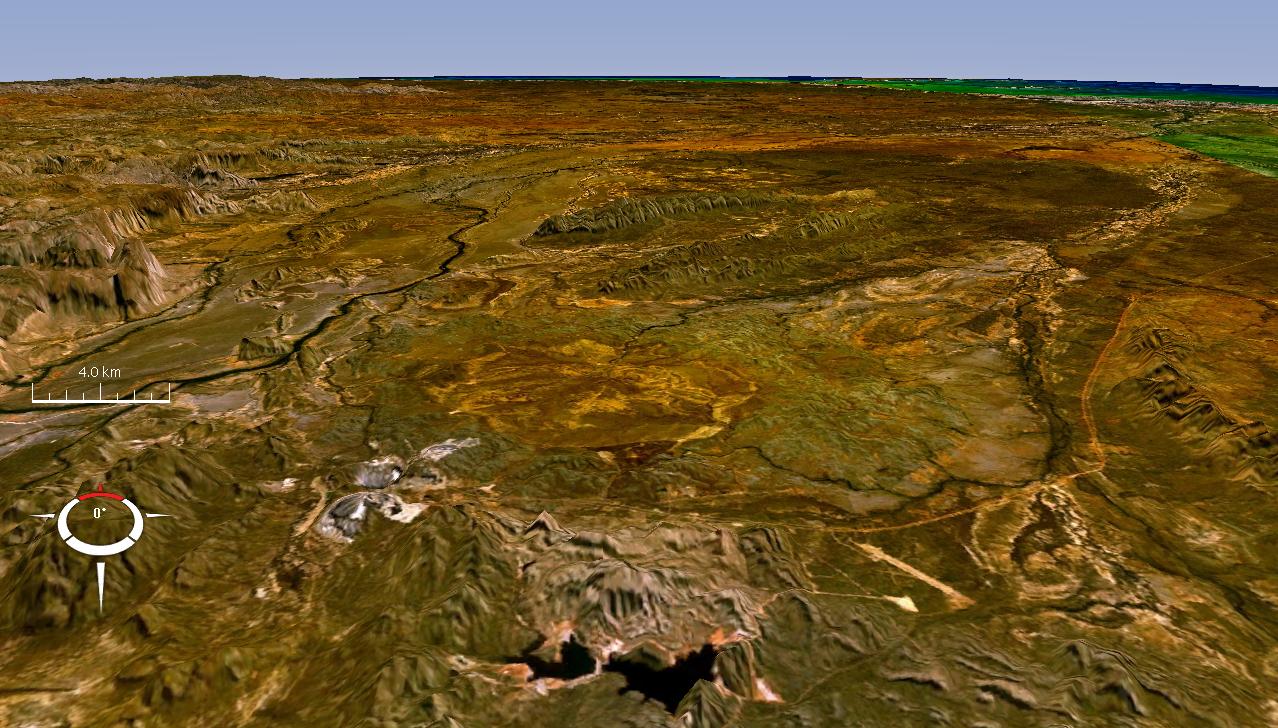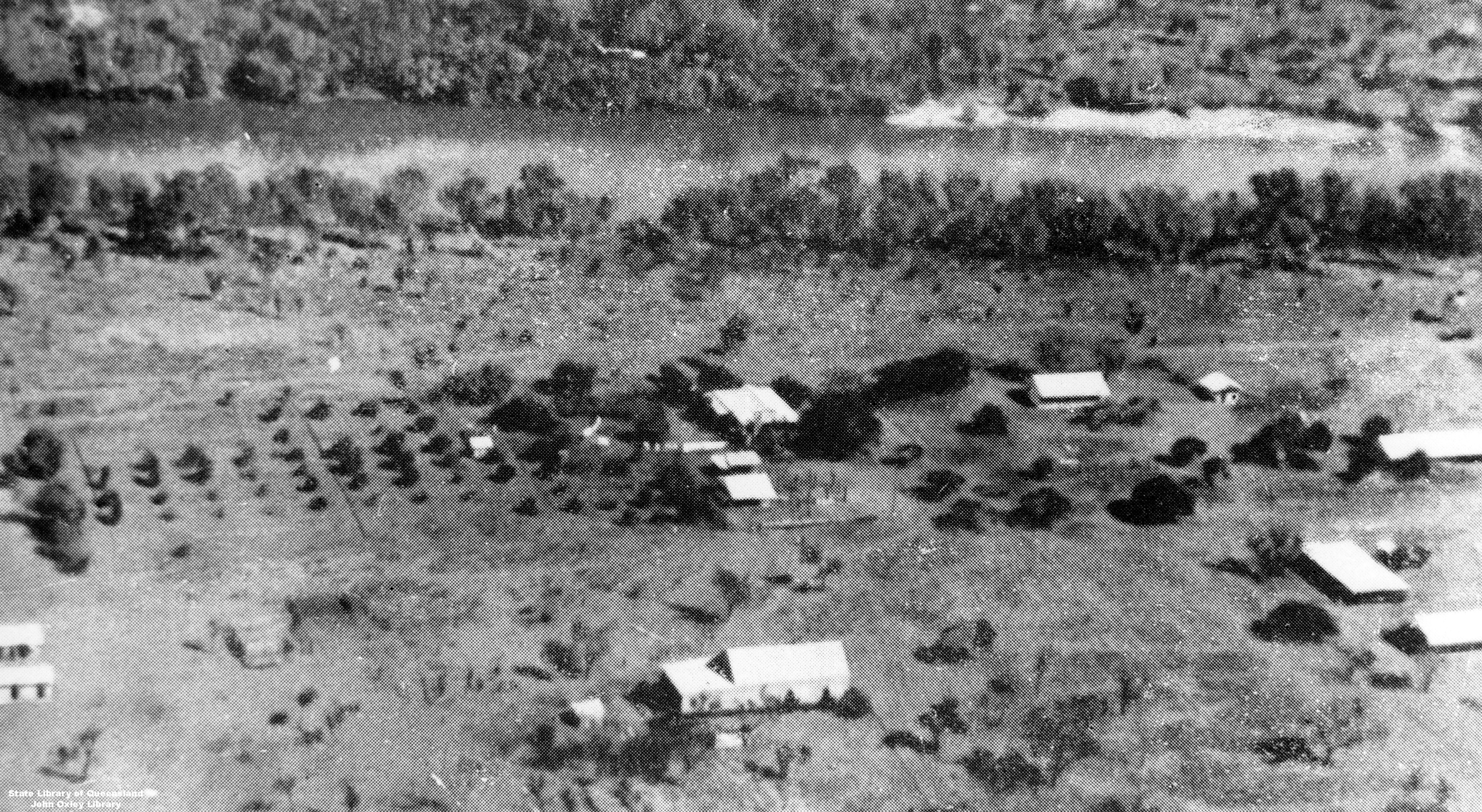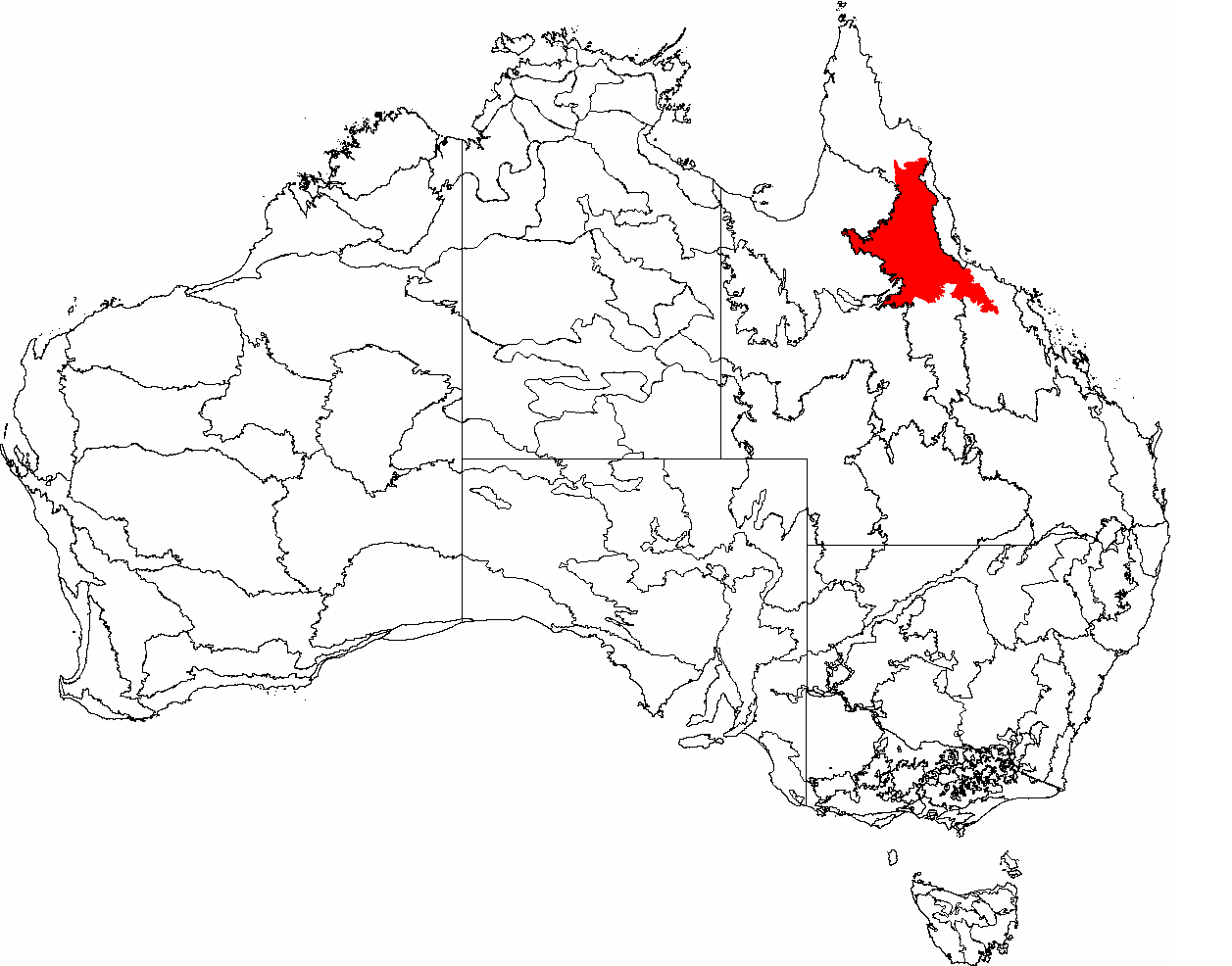|
Gulf Country
The Gulf Country or North West Queensland is the region of woodland and savanna grassland surrounding the Gulf of Carpentaria in north western Queensland and eastern Northern Territory on the north coast of Australia. The region is also called the Gulf Savannah. The Gulf Country is crossed by the Savannah Way highway. The flat, savannah land has a dry season and a monsoon, containing the largest areas of native grassland in Australia. It is used for raising cattle and mining. It contains large reserves of zinc, lead and silver. The area is home to a number of endangered species and is crossed by a number of major rivers. The first known European explorer of the region was Willem Janszoon. Location and description The Gulf Country is a block of dry savanna between the wetter areas of Arnhem Land and the Top End of the Northern territory to the west and the Cape York Peninsula of Far North Queensland to the east, while to the south and east lie upland plains of Mitchell gr ... [...More Info...] [...Related Items...] OR: [Wikipedia] [Google] [Baidu] |
Electoral District Of Traeger
Traeger is an electoral district of the Legislative Assembly in the Australian state of Queensland. It was created in the 2017 redistribution, and was named after Alfred Traeger, inventor of the pedal-powered radio, which was a significant contribution to people living in remote and rural communities in Queensland, such as those within Traeger. It takes in most of the urbanised portions of the abolished districts of Mount Isa and Dalrymple. It includes the local government areas of Burke, Doomadgee, Carpentaria, Croydon, Etheridge, Charters Towers, Mount Isa, Cloncurry, McKinlay, Richmond and Flinders. From results of the previous 2015 election, Traeger was estimated to be a safe seat for the Katter's Australian Party with a margin of 16.1%. Robbie Katter, the last member for Mount Isa and the Queensland leader of Katter's Australian Party, opted to follow most of his constituents into Traeger. He won the seat with an increased majority. Members for Traeger Electio ... [...More Info...] [...Related Items...] OR: [Wikipedia] [Google] [Baidu] |
Savannah Way
The Savannah Way is a route of highways and major roads across the tropical savannahs of northern Australia, linking Cairns in Queensland with Broome in Western Australia. Promoted as a self-drive tourist route, it joins Cairns, Normanton, Borroloola, Katherine, Kununurra, Fitzroy Crossing, Derby and Broome. It has been designated by the Queensland Government as a State Strategic Touring Route. Licensed as CC BY 3.0 AU. File:Savannah Way 0216.svg Much of the route is Highway 1; however, much of it is on unsealed roads. It runs for a distance of . Parts of Savannah Way form part of the National Highway network. Alternate routes are signposted along the way allowing travellers different options from the main Savannah Way. From Cairns they include travel via Chillagoe and the Burke Developmental Road to Karumba; via Einasleigh and Forsayth to Georgetown; via Gregory Downs to Boodjamulla National Park (Lawn Hill) and Bowthorn station; via Daly Waters and Top Sp ... [...More Info...] [...Related Items...] OR: [Wikipedia] [Google] [Baidu] |
Doomadgee, Queensland
Doomadgee is a town and a locality in the Aboriginal Shire of Doomadgee, Queensland, Australia. It is a mostly Indigenous community, situated about from the Northern Territory border, and west of Burketown. The settlement began with the establishment of the Doomadgee Mission in 1933, which relocated from Bayley Point to Nicholson River in 1936. In the , the locality of Doomadgee had a population of 1,387 people. History Indigenous peoples The Waanyi and Ganggalidda (Yukulta) people are the recognised Aboriginal Australian peoples who are the traditional owners for the region surrounding Doomadgee. Historically, Gadawa, Lardil, Mingginda and Garawa groups inhabited or traversed the area. The Waanyi language (also known as ''Wanyi'', ''Wanyee'', ''Wanee'', ''Waangyee'', ''Wonyee'', ''Garawa'', and ''Wanji)'' is an Australian Aboriginal language of the Gulf Country. The language region includes the western parts of Lawn Hill Creek and Nicholson River, from abou ... [...More Info...] [...Related Items...] OR: [Wikipedia] [Google] [Baidu] |
Mount Isa
Mount Isa ( ) is a city in the Gulf Country region of Queensland, Australia. It came into existence because of the vast mineral deposits found in the area. Mount Isa Mines (MIM) is one of the most productive mines in world history, based on combined production of lead, silver, copper and zinc. Before European contact, the Mount Isa region was part of an expansive trade network spanning the entire Lake Eyre basin, Lake Eyre Basin and beyond. In particular, it was a valued source of stone for stone tools such as Hand axe, hand axes.Davidson, Iain; Cook, Nick; Fischer, Matthew; Ridges, Malcolm; Ross, June; Sutton, Stephen (2005). "Archaeology in Another Country: Exchange and Symbols in North-West Central Queensland" (PDF). In Macfarlane, Ingereth; Mountain, Mary-Jane; Paton, Robert (eds.). Many Exchanges: Archaeology, History, Community and the Work of Isabel McBryde. Canberra: Aboriginal History Inc. pp. 101–128. In the , the town of Mount Isa had a population of 18,317 peop ... [...More Info...] [...Related Items...] OR: [Wikipedia] [Google] [Baidu] |
Wellesley Islands
The Wellesley Islands, also known as the North Wellesley Islands, is a group of islands off the coast of Far North Queensland, Australia, in the Gulf of Carpentaria. It is a locality within the Shire of Mornington local government area. The traditional owners of the islands are the Lardil people. In the , Wellesley Islands had a population of 1,022 people. Geography The Wellesley Islands, also known as the North Wellesley Islands, is located in the Gulf of Carpentaria, on the eastern (Queensland) side of the gulf. The largest island in the group is Mornington Island, with most people living in the town of Gununa. Two small islands in the group, north of Mornington Island, are designated as the Manowar and Rocky Islands Important Bird Area, because of their importance for breeding seabirds, in particular the brown booby and lesser frigatebird. Other islands in the group include (from north to south): * Moondalbee Island * Lingnoonganee Island * Pisonia Island * Lingeleah Is ... [...More Info...] [...Related Items...] OR: [Wikipedia] [Google] [Baidu] |
Sir Edward Pellew Group Of Islands
The Sir Edward Pellew Group of Islands is situated in the south-west corner of the Gulf of Carpentaria, off the coast of the Northern Territory, Australia. History They were named in 1802 by Matthew Flinders in honour of Edward Pellew, 1st Viscount Exmouth, Sir Edward Pellew, a fellow naval officer. Although Flinders was the first British explorer to pass that way, his journals describe indications of some "foreign" people having visited beforehand. Flinders speculated that these visitors were Chinese. The islands were also sighted in 1644 by Abel Tasman who thought they were part of the mainland and called them "Cape Vanderlin". Description The group includes Vanderlin Island, North Island (Australia), North Island, West Island (Australia), West Island, Centre Island (Australia), Centre Island and South West Island (Northern Territory), South West Island. Combined, the islands have a total area of 2100 square kilometres; the largest, Vanderlin Island, is 32 km long and 1 ... [...More Info...] [...Related Items...] OR: [Wikipedia] [Google] [Baidu] |
Savannah
A savanna or savannah is a mixed woodland-grassland (i.e. grassy woodland) biome and ecosystem characterised by the trees being sufficiently widely spaced so that the canopy does not close. The open canopy allows sufficient light to reach the ground to support an unbroken herbaceous layer consisting primarily of grasses. Four savanna forms exist; ''savanna woodland'' where trees and shrubs form a light canopy, ''tree savanna'' with scattered trees and shrubs, ''shrub savanna'' with distributed shrubs, and ''grass savanna'' where trees and shrubs are mostly nonexistent.Smith, Jeremy M.B.. "savanna". Encyclopedia Britannica, 5 Sep. 2016, https://www.britannica.com/science/savanna/Environment. Accessed 17 September 2022. Savannas maintain an open canopy despite a high tree density. It is often believed that savannas feature widely spaced, scattered trees. However, in many savannas, tree densities are higher and trees are more regularly spaced than in forests.Manoel Cláudio da S ... [...More Info...] [...Related Items...] OR: [Wikipedia] [Google] [Baidu] |
Beef Cattle
Beef cattle are cattle raised for meat production (as distinguished from dairy cattle, used for milk (production)). The meat of mature or almost mature cattle is mostly known as beef. In beef production there are three main stages: cow-calf operations, backgrounding, and feedlot operations. The production cycle of the animals starts at cow-calf operations; this operation is designed specifically to breed cows for their offspring. From here the calves are backgrounded for a feedlot. Animals grown specifically for the feedlot are known as feeder cattle, the goal of these animals is fattening. Animals not grown for a feedlot are typically female and are commonly known as replacement Cattle, heifers. While the principal use of beef cattle is meat production, other uses include leather, and beef by-products used in candy, shampoo, cosmetics, and insulin. Calving and breeding Besides breeding to meet the demand for beef production, owners also use selective breeding to attain specific ... [...More Info...] [...Related Items...] OR: [Wikipedia] [Google] [Baidu] |
Einasleigh Uplands
The Einasleigh Uplands is an interim Australian bioregion, with vegetation consisting of savanna and woodland located on a large plateau in inland Queensland, Australia. It corresponds to the Einasleigh Uplands savanna ecoregion, as identified by the World Wildlife Fund. Location and description This area is inland from the moist Queensland coast but is not as dry as the Brigalow Belt and the Mitchell Grass Downs savannas to the south, while the Cape York Peninsula to the north is lower-lying and wetter. The region contains a number of specialised habitats that add to the variety of wildlife found here. These include lava tubes and caves such as those of Chillagoe. The uplands are an area of eroded volcanic rock on and to the west of the Atherton Tableland in the northern section of Australia's Great Dividing Range running inland as far as the town of Croydon in the southwest. The plateau is covered in grassland dotted with eucalyptus trees and cut through with ridges, gorge ... [...More Info...] [...Related Items...] OR: [Wikipedia] [Google] [Baidu] |
Astrebla
''Astrebla'' is a small genus of xerophytic (adapted to survive in an environment with little liquid water) grasses found only in Australia. They are the dominant grass across much of the continent. They are commonly known as Mitchell grass after Scottish explorer Thomas Mitchell (1792-1855), who first collected a specimen near Bourke in New South Wales. Mitchell grasses grow on clay soils, mainly between an upper limit of and a lower limit of average annual rainfall, and at even lower rainfall in depressions where the water concentrates following rains, for example in Sturt's Stony Desert. Mitchell grasses are deep-rooted and become dormant during drought, allowing them to survive extended periods without rainfall. They are commonly found clumped together and reaching one metre high, providing habitat for organisms such as mammals. ; Species See also * List of Poaceae genera Poaceae, also known as the true grasses, is the fourth largest plant family in the world with ... [...More Info...] [...Related Items...] OR: [Wikipedia] [Google] [Baidu] |
Far North Queensland
Far North Queensland (FNQ) is the northernmost part of the States and territories of Australia, Australian state of Queensland. Its largest city is Cairns, Queensland, Cairns and it is dominated geographically by Cape York Peninsula, which stretches north to the Torres Strait, and west to the Gulf Country. The waters of Torres Strait include the only international border in the area contiguous with the Australian mainland, between Australia and Papua New Guinea. The region is home to three World Heritage Sites, the Great Barrier Reef, the Wet Tropics of Queensland and Australian Fossil Mammal Sites (Riversleigh), Riversleigh, Australia's largest fossil mammal site. Far North Queensland lays claim to over 70 national parks, including Mount Bartle Frere; with a peak of it is the highest peak in both Northern Australia and Queensland. The Far North region is the only region of Australia that is the indigenous country of both Aboriginal Australians and Torres Strait Islanders. Far ... [...More Info...] [...Related Items...] OR: [Wikipedia] [Google] [Baidu] |
Cape York Peninsula
The Cape York Peninsula is a peninsula located in Far North Queensland, Australia. It is the largest wilderness in northern Australia.Mittermeier, R.E. et al. (2002). Wilderness: Earth's last wild places. Mexico City: Agrupación Sierra Madre, S.C. The land is mostly flat and about half of the area is used for grazing cattle. The relatively undisturbed eucalyptus-wooded savannahs, tropical rainforests and other types of habitat are now recognised and preserved for their global environmental significance. Although much of the peninsula remains pristine, with a diverse repertoire of endemic flora and fauna, some of its wildlife may be threatened by industry and overgrazing as well as introduced species and weeds.Mackey, B. G., Nix, H., & Hitchcock, P. (2001). The natural heritage significance of Cape York Peninsula. Retrieved 15 January 2008, froepa.qld.gov.au. The northernmost point of the peninsula is Cape York (Queensland), Cape York. The land has been occupied by a number of ... [...More Info...] [...Related Items...] OR: [Wikipedia] [Google] [Baidu] |








